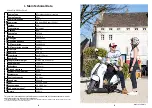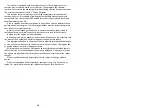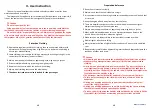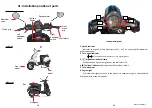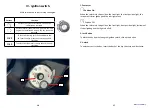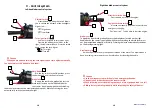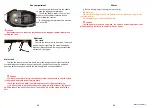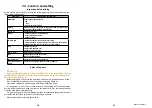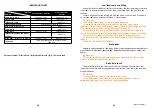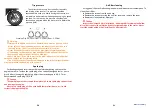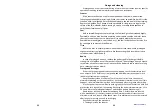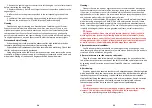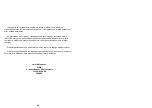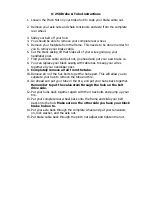
34
35
2. Remove the spark plug; press the starter to let the engine run for a few moments
before reinstalling the spark plug.
3. Replace the battery. Note: Do not forget to connect the positive pole before the
negative pole.
4. Inflate the tires to the pressure specified in the corresponding section of this
manual.
5. Lubricate all the parts requiring it by proceeding as indicated in this manual.
6. Observe the instructions in “Pre-ride inspection” before setting off.
Cleaning
Frequent and regular cleaning is an essential part of maintaining your Scooter.
Exposure to natural elements (sea breeze, sea water, mud, dust, etc.) and to non-
slip additives spread on the roads in winter, can be a source of vulnerability for the
components of your Scooter. Corrosion and rust can appear even on good quality
parts. Proper maintenance and regular cleaning of your vehicle will not only prolong
its original appearance, but also are essential in order to maintain warranty rights.
Precautions Before Cleaning
When the engine is cold, protect the exhaust outlet with suitable protection
(example: plastic bag) to prevent water from entering inside.
Exposed electrical components should be covered with a plastic bag. Check that
the lids and caps are correctly positioned.
Using a degreaser and a soft brush, remove any major stains that may be on the
crankcase, making sure never to apply it to the gears, transmission chain, seals and
wheel axles. Rinsing of residues and degreaser will be done with water.
Cleaning :
Cleaners that are too acidic or aggressive are not recommended for washing the
Scooter. Particularly at the level of axles, bearings, levers, pivots, wheels and spokes.
If, however, it is necessary to use it for stubborn stains, follow the instructions and
application times for the product. We recommend that you spray these parts with an
anti-corrosion product after rinsing with plenty of water.
Plastic parts and windshields (for equipped vehicles) should preferably be cleaned
with water using a sponge or soft cloth. Only a mild detergent can be used if some
plastic parts cannot be cleaned properly. Rinse the product used abundantly: poorly
rinsed, it could damage the plastic parts. The use of all other products on plastic parts
is strictly discouraged (thinner, solvent, gasoline, antifreeze, abrasive cleaner, etc.).
Caution
Special precautions: Do not use a high pressure cleaner or steam jet: Avoid
directing the water jet near the following items: on-board instruments, brake
cylinders and calipers, under the fuel tank, transmission chain, bearings steering
column, gaskets, air box, wheel or swingarm bearings, all electrical components
as well as air vents. Water infiltration could damage these elements.
After use under normal conditions:
Soak in lukewarm water mixed with a mild detergent using a soft sponge, then
rinse thoroughly. A damp cloth placed for a few minutes on parts with more stubborn
stains and insects, will loosen dirt gently.
After use in the rain, near the sea or on salty roads:
Clean the Scooter with cold water and a mild detergent: do not use hot water,
this will increase the corrosive action of the salt. Protect the vehicle from corrosion
by spraying an anti-corrosion product on all metallic, chrome or nickel-plated
surfaces.
After cleaning:
Dry body parts with a chamois leather or soft absorbent paper. After being dried
with a disposable cloth, the transmission chain should be lubricated with a specific
lubricant to prevent it from rusting. It is advisable to scrub chrome or stainless
steel parts (including the exhaust system) with a chrome cleaner. An anti-corrosion
product should be sprayed on all metallic, chrome or nickel-plated surfaces.
Lubricate the pivot pins, bolts and nuts. Apply wax to all painted parts.
Caution
Special precautions: Never use lubricating or greasy products on the braking
elements. This could decrease braking efficiency and cause an accident.
Always use a specific degreaser for braking systems.


